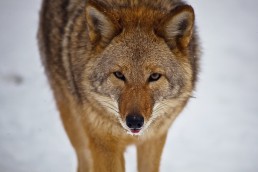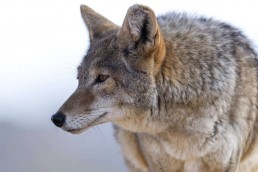Coyote Hunting an Alternative in February
SHARE THIS POST
Coyotes can be an excellent challenge for the hunter who just hates to see the end of another hunting season and wishes it could continue. With the third season for deer hunting ending and the deer archery hunting having ended in mid-January, and, with the exception of some small game, rabbits, and pay game farms, that still leaves the rest of February and most of March for putting the field to good use by going coyote hunting.
Most landowners, who sometimes frown on allowing hunters onto their property nowadays, usually are happy to say, “Yes” when the quarry is a coyote. (Also, once the landowner recognizes you are a capable, trustworthy hunter, it may open the door for future hunting endeavors there.)
Coyotes are intelligent and have proliferated in all kinds of environments, despite the many attempts at reducing their numbers. Many times, I have seen coyotes searching for mice and other critters to dine on, and the coyote would barely pay attention to my moving vehicle. But if I slowed down noticeably more, that coyote would head for the next county.
Recently, they have even become bold enough to call small suburban communities their “home,” many times preying on family pets. Of course, distinguishing a coyote from some other animal is a must.
Here are some characteristics to help you identify your quarry: A coyote, although somewhat smaller—20 to 40 pounds—resembles a wolf or husky in that its fur is a reddish-grey color and its tail is quite bushy, though not as bushy as a fox’s tail. To distinguish the coyote from the wolf consider that a wolf will hold its tail high while hunting, and a coyote will keep its tail down and often look like it’s “slinking.” The coyote also has somewhat larger, pointed ears. But its footprints and droppings are quite similar to those of a domestic dog. Its familiar howl and its green-gold glittery eyes clearly separate it from the domestic animal.
The coyote prefers hunting in open “brush” country as opposed to thick woodlands, although it is not opposed to such surroundings should the animal feel threatened in the open country. Coyotes pair for life and den up and mate in February. Their dens can usually be located under roots of old trees, or dug in the deep slopes of a hill or among large rocks or boulders close to woods. They use ravines and other naturally concealed corridors to move from one area to another. They will usually stakeout a territory of about 30 square miles, and concealment and stealth is their best asset.
Are you enjoying this post?
You can be among the first to get the latest info on where to go, what to use and how to use it!
As far as what kind of firearm will do the best, any gun capable of shooting at least 150 is preferred. I have known some hunters to use shotguns with deer slugs or heavy buckshot, but the shotgun really doesn’t have the range for consistent shooting. After all, these animals have not proliferated over the years by getting close to man; their sense of smell, sight and sound are superior. Any long-shooting caliber gun will suffice, such the .17HMR, .204, .220 Swift, .222, .22-250 or the .223. All are good varmint calibers and there are some new smaller calibers hitting the market all the time, but use the aforementioned rounds and you will have no trouble bringing down a coyote.
You can also go to the opposite ends of the spectrum: For example, the 22WSM magnum 22 is okay, but lacks the serious punch at longer distances. Or, you can go to the 243, 270, or the 30-06 calibers—these in my opinion would be overkill for the coyote. Although, I must confess that I own a 760 Remington pump 30-06 rifle, and loaded it with accelerator 55-grain bullets that attain a speed of 4,000-feet-plus per second; it might be overkill, but the bullet gets there very fast, and properly-scoped targets of 300 to 400 yards are not that difficult.
A real sensible choice of weapon is the .223-rifle, with a good variable 3×9 scope. It has all the qualifications to be a good coyote/varmint gun and the ammunition runs at about half the cost of some other similar calibers. Your pocket can be your best judge too.
Having said all that, there are a number of ways to hunt coyotes. Some loosely knit coyote hunting clubs make a day of it by locating themselves in strategic places around a field or woods known to be inhabited by coyotes, and then use dogs to run coyotes into the open to be targeted. This is my least favorite way. Chances of accidentally shooting a dog, or worse yet, a hunting partner, can increase—not to mention coyotes in that situation are running like heck. Locating oneself strategically in an expanse woods next to some brushy fields in full camouflage and good cover with a variety of predator calls is the most logical. They may not always be where you have located yourself, so be flexible and have plans B and C ready.
If you are not successful, don’t be afraid to move after you have spent a reasonable amount of time there. Remember, I didn’t say that coyote hunting was easy; I said it was a challenge. Some serious coyote hunters will invest in electronic predator calls that can lure your quarry within shooting range. How serious you are will dictate how you choose to hunt these worthy adversaries. If, after you are successful, when treated properly by a qualified taxidermist, the coyote pelt can be made into a pretty good-looking wall hanging or small throw rug.
MWO
SHARE THIS POST
Did you enjoy this post?
You can be among the first to get the latest info on where to go, what to use and how to use it!
Herman Kunz
Herman Kunz is a freelance writer specializing in all types of hunting, freshwater fishing and other outdoor-related activities, including seminar speaking and promotions. Kunz is on the field advisory staffs of Rapala, Flambeau tackle systems and Storm Lures, and may be reached at 618-599-2400.


